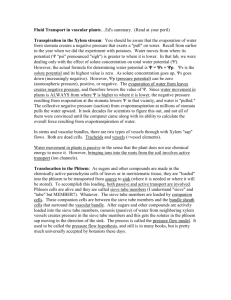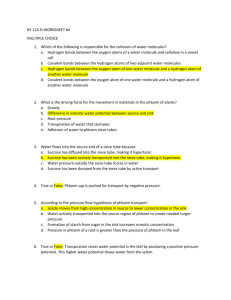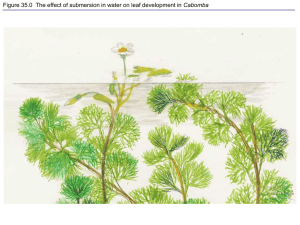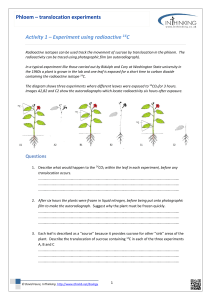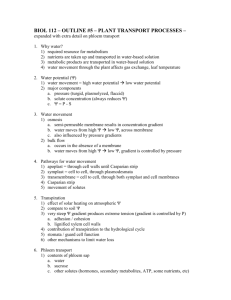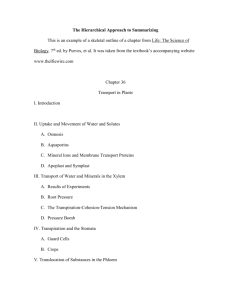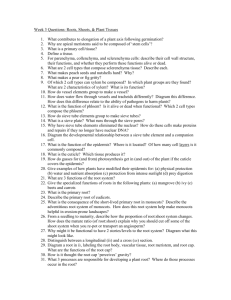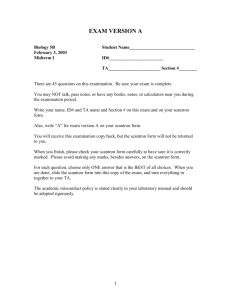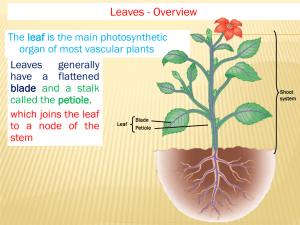Ch36 PowerPoint LN
advertisement
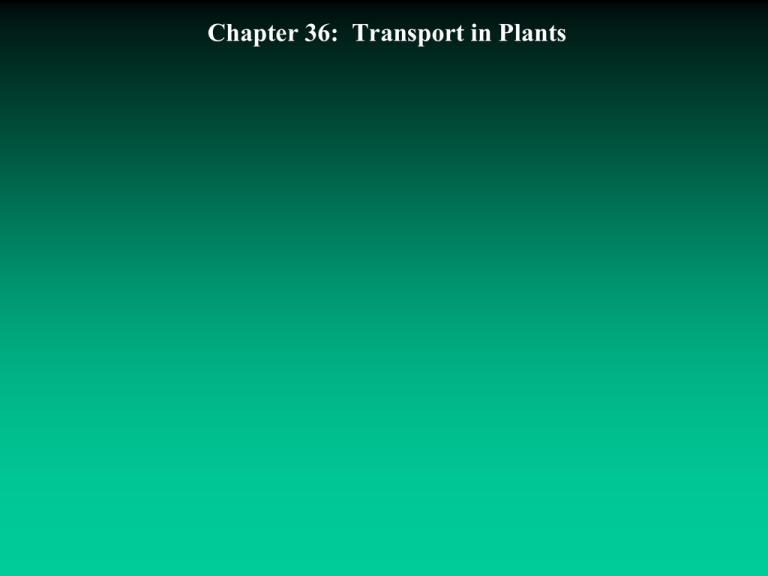
Chapter 36: Transport in Plants Figure 36.1 An overview of transport in whole plants (Layer 4) 1. Role of phloem in transporting phloem sap 2. Respiration in roots 3. Root absorption of water and minerals 4. Xylem flow of water 5. Transpiration Figure 36.2 A chemiosmotic model of solute transport in plant cells Figure 36.3 Water potential and water movement: a mechanical model Figure 36.4 Water relations of plant cells Figure 36.5 A watered tomato plant regains its turgor Figure 36.6 Compartments of plant cells and tissues and routes for lateral transport Figure 36.7 Lateral transport of minerals and water in roots Figure 36.9 Guttation: caused by root pressure Figure 36.10 The generation of transpirational pull in a leaf Figure 36.11 Ascent of water in a tree Figure 36.12 An open (left) and closed (right) stoma of a spider plant (Chlorophytum colosum) leaf Figure 36.12x Stomata on the underside of a leaf Figure 36.13a The mechanism of stomatal opening and closing Figure 36.13b The mechanism of stomatal opening and closing The Physiology of Stomatal Opening • Three Cues • Light causes the guard cells to accumulate potassium ions and thus increase turgidity. •Blue-light receptor in the guard cells which senses light and activates a pump (ATP required) to uptake potassium ions. • CO2 Depletion within the leaf air spaces. This occurs right at the beginning of PS. • Internal Clock: which operates even if you keep the plant in the dark so the plant has some sort of internal mechanism for regulating the opening of the stomates. The Physiology of Stomatal Closing • Water Deficiency • Hormonal control (abscisic acid) produced in responses to drought conditions will cause guard cells to close the stomata. • High Temperatures: may occur by increasing carbon dioxide levels within the leaf as respiration increases Figure 36.15 Structural adaptations of a xerophyte leaf 1. Thickened cuticle 2. Outermost (dermal) tissue is multilayered 3. Stomata are recessed in pits. 4. Hairs or trichomes create a protected layer of water vapor near the leaf. Phloem translocates its sap from sugar sources to sugar sinks • Sucrose made during PS will travel symplastically. • It can leave the symplast and then travel apoplastically • From the cell wall it can then be “dumped into” or loaded into the companion cells and sieve tube members thus increasing the concentration of sugar in these cells. • This movement into the companion cells and sieve tube members is thought to be done with the help of proton pumps. • The hydrogen ions that are pumped into the apoplast are then cotransported with the sucrose back into the companion or sieve tube cell. Figure 36.16 Loading of sucrose into phloem Figure 36.17 Pressure flow in a sieve tube 1. As sucrose gets loaded into the sieve tube members the water potential goes down. 2. Water then enters the sieve tube member from a neighboring xylem vessel. 3. This causes the buildup of pressure, hydrostatic pressure which forces the sap to flow. 4. Since sucrose is being taken up at a “sink”, water pushes the sucrose in that direction. Figure 36.18 Tapping phloem sap with the help of an aphid Figure 36.0 Eucalyptus trees Figure 36.0x Trees Figure 36.1 An overview of transport in whole plants (Layer 1) Figure 36.1 An overview of transport in whole plants (Layer 2) Figure 36.1 An overview of transport in whole plants (Layer 3) Figure 36.8 Mycorrhizae, symbiotic associations of fungi and roots Figure 36.14 A patch-clamp study of guard cell membranes Figure 36.15x Structural adaptations of a xerophyte leaf
